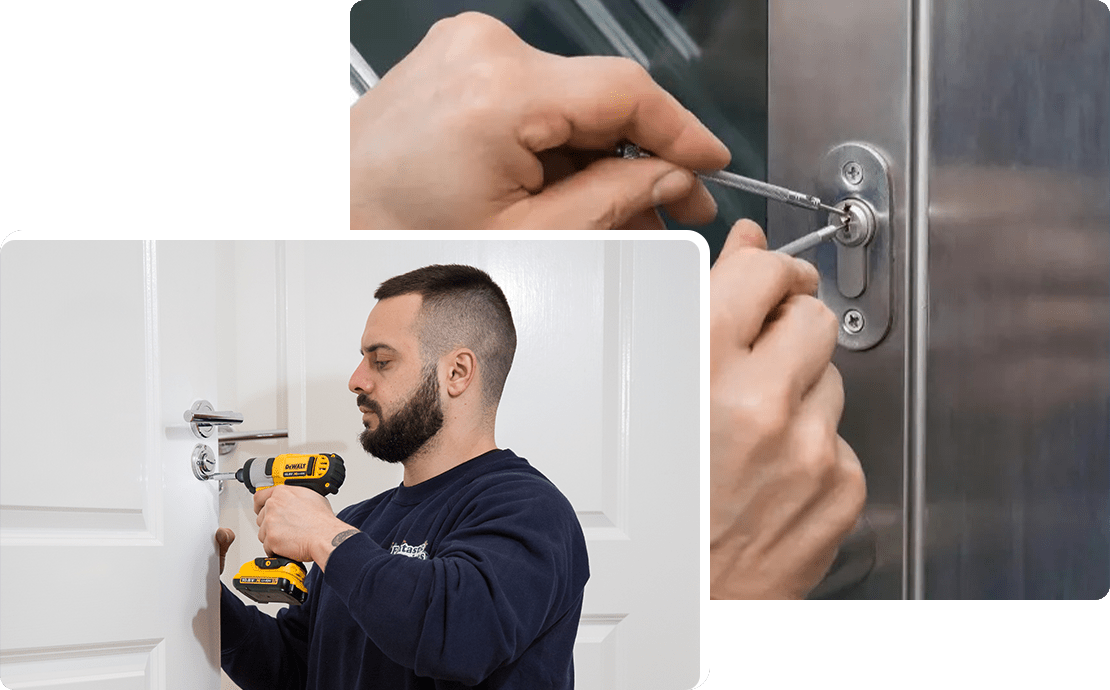
Revamping the security and aesthetic appeal of your home can start right at the entrance with a simple yet impactful DIY project – replacing your door handle with a lock. Whether you’re motivated by a desire for enhanced security or simply looking to refresh the look of your door, we are here to guide you through the process.
Just keep in mind that these steps may vary based on the lockset you choose, making it imperative to consult the manufacturer’s guidelines for precise instructions. So, grab your tools and a cup of tea, and let’s transform that door into a stylish and secure entry point for your home!
Replacing a door handle with a lockWhat will you need beforehand?
- New door lockset
- Screwdriver
- Tape measure
- Pencil
- Hole saw or spade bit
- Chisel
- Hammer
- Wood glue
- Strike plate
- Wood screws
Step 1: Bid farewell to the old handle
Begin by using a screwdriver to detach the screws holding the old door handle in place. This will free the handle from both sides of the door. Once removed, you’ll find the latch mechanism – proceed to remove its securing screws to take it out.
Step 2: Measure and mark
Precision is key in this step. Measure the backset of the existing latch, which is the distance from the edge of the door to the centre of the hole for the doorknob or lever. Common backset sizes are 2-3/8 inches or 2-3/4 inches. Mark the centerline for the new lockset on both sides of the door.
Step 3: Drill the holes
Equip yourself with a hole saw or spade bit to drill a hole in the centre of the door for the new lockset. Ensure that the hole is of the appropriate size for your chosen lockset. Simultaneously, drill a hole for the latch at the door’s edge, aligning it with the previously marked centerline.
Step 4: Chisel out the mortise
With a chisel, create a mortise for the latch plate on the edge of the door. The depth of the mortise should match the thickness of the latch plate. Additionally, chisel out a recess for the strike plate on the door frame.
Step 5: Install the new lockset
Carefully position the latch, ensuring it aligns perfectly with the designated hole on the side of the door. Use the screws to firmly secure the latch in place, ensuring a snug fit. Now, introduce the external component of the lockset through the front side of the door, ensuring a seamless connection with the internal counterpart. Take extra care to tighten the screws adequately, applying the necessary pressure to guarantee stability.
To ensure optimal functionality, conduct a thorough test of the latch mechanism. Confirm that it moves effortlessly and without any resistance, verifying that the installation has been executed with precision.
Step 6: Install the strike plate
Secure the strike plate onto the door frame by affixing it with screws, meticulously aligning it to ensure a precise match with the latch mechanism. Take care to position the strike plate accurately, verifying that it sits flush and securely against the door frame.
Use the screws to fasten it in place, making certain that each screw is tightened adequately to guarantee a stable and reliable attachment. This meticulous attention to detail in affixing the strike plate contributes to the overall effectiveness and longevity of the door mechanism.
Step 7: Adjustments
Inspect the alignment of both the lock and latch components meticulously. If there are any discrepancies or misalignments detected, consider making minor adjustments to ensure optimal functionality. Take the time to carefully assess the interplay between the lock and latch, ensuring they engage smoothly and seamlessly.
Step 8: Final checks
Close and open the door multiple times to confirm that the lock and latch function correctly. Tighten all screws securely to complete the installation.
Remember, if any step feels challenging, it’s always wise to seek assistance from a professional locksmith or handyman. Enjoy your upgraded door handle and heightened security!
Additional tips and considerations
- Choose the right lockset – When selecting a new lockset, consider the security features it offers. Look for high-quality materials, advanced locking mechanisms, and compatibility with your door type.
- Door material – Different doors may require different installation techniques. For example, wooden doors might be easier to work with than metal or fibreglass doors. Adjust your approach based on the door material.
- Door thickness – Ensure that the lockset you choose is compatible with the thickness of your door. Some locksets are designed for specific door thicknesses, and using the wrong one can affect security and functionality.
- Test the keys – Before considering the installation complete, test the keys to ensure they turn smoothly in the lock and that the lock engages and disengages without any issues.
- Paint or finish – If your new lockset has a different finish than the old one, consider repainting or refinishing the door to match. This can enhance the overall aesthetics of your entryway.
- Read the manual – Always refer to the manufacturer’s instructions that come with your new lockset. These instructions provide specific details and tips for the particular product you are installing.
When to call a locksmith
While DIY installation is achievable, there are instances when calling a licensed local locksmith is advisable. If you encounter complexities like door material that’s hard to work with or misaligned holes, or if you simply want assurance of a job perfectly done, a locksmith’s expertise can be invaluable.
Conclusion
Upgrading your door handle to a lock is a worthwhile DIY project, offering improved home security when done correctly. Armed with the right tools, meticulous measurements, and patience, you can successfully install a new lock.
However, for the highest level of family safety and peace of mind, it’s wise to recognise the expertise of professional locksmiths. Their precision and skill not only ensure proper installation but also provide valuable insights into additional security measures, making them a crucial resource in fortifying your home against potential threats.
In the balance between a satisfying DIY experience and comprehensive security, a professional locksmith remains just a call away, ready to enhance and optimise your home’s protection.


